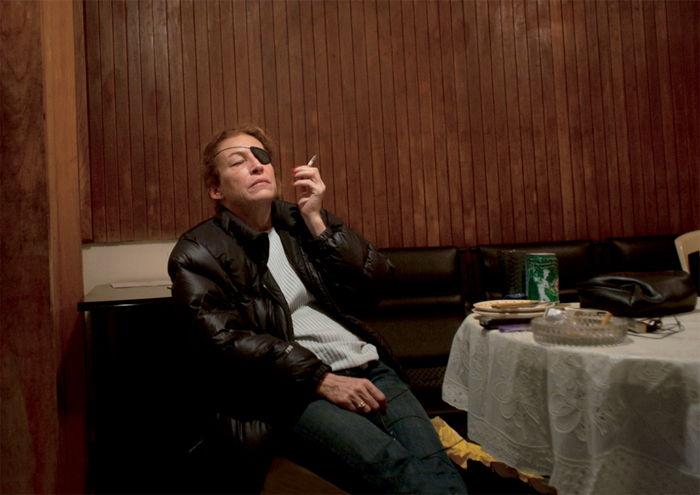
-
Marie Colvin
woman's style ~女性の肖像~ vol.1
Marie Colvin
黒い眼帯、隻眼の記者で知られるメリー コルビン
2012年シリアのホムスで反政府軍の砲弾で帰らぬ人となった
1956年 アメリカ ニューヨーク州生まれ
エール大(Yale University)卒業後、UPI通信で夜勤の警察番記者としてキャリアをスタート その後、同通信パリ支局長を務め、1986年にサンデー・タイムズに入社。
英ロンドン(London)を拠点に、レバノン内戦や第1次湾岸戦争、チェチェン紛争、東ティモール紛争と、四半世紀にわたって世界の紛争・戦争を取材し、最近は中東各地から「アラブの春」を報じている
紛争に巻き込まれた人々について伝えることを信条に、30年以上に渡り数多くの紛争地を献身的かつ勇敢に取材を繰り返す 2001年にスリランカ内戦を取材中に手榴弾の破片が当たり、左目を失明。 この怪我で心的外傷後ストレス障害(PTSD)を負ったが、取材競争を続けることによってそれを克服 この時から着けている黒い眼帯はシンボルとなり隻眼の記者で知られ、vanity fair誌やvogue UKなどでも特集が組まれる。
中東では ジャーナリストとしては最も危険であるが取材価値としてキャリアを磨く事ができる地であったが同時に最も危険性をはらんだ地域でもある。昨年にはリビアで「レストレポ」で知られる戦場カメラマンでドキュメンタリー映画監督でもあるティム ヘザリントン、米国人カメラマンのクリス・ホンドロスが取材中に砲撃を受け死亡、今年に入り日本のジャーナリスト山本美香もシリア騒乱で銃撃を受け他界。
メリー•コルビンも2012年シリアのホムスで反政府軍の砲弾を受けて帰らぬ人となった 彼女の死の数時間前に英BBCテレビに電話でシリア騒乱で爆弾の金属片が当たった2歳の男児の死亡の現場をリポートしている
サンデー・タイムズはコルビン氏の最後の特報となった19日掲載の記事を、無料でオンライン公開した。
http://www.thesundaytimes.co.uk/sto/public/news/article874796.ece
その記事は以下
I entered Homs on a smugglers' route, which I promised not to reveal, climbing over walls in the dark and slipping into muddy trenches. Arriving in the darkened city in the early hours, I was met by a welcoming party keen for foreign journalists to reveal the city's plight to the world. So desperate were they that they bundled me into an open truck and drove at speed with the headlights on, everyone standing in the back shouting "Allahu akbar" ― God is the greatest. Inevitably, the Syrian army opened fire.
When everyone had calmed down I was driven in a small car, its lights off, along dark empty streets, the danger palpable. As we passed an open stretch of road, a Syrian army unit fired on the car again with machineguns and launched a rocket-propelled grenade. We sped into a row of abandoned buildings for cover.
The scale of human tragedy in the city is immense. The inhabitants are living in terror. Almost every family seems to have suffered the death or injury of a loved one.
Khaled Abu Salah, an activist who took part in the first demonstrations against Assad in Homs last March, sat on the floor of an office, his hand broken and bandages covering shrapnel wounds to his leg and shoulder.
A 25-year-old university student, who risked his life filming videos of the slaughter of Baba Amr residents, he narrowly escaped when he tried to get two men wounded by mortar fire to a makeshift clinic.
He and three friends had just taken the wounded to the clinic, which was staffed by a doctor and a dentist, and stepped away from the door when "a shell landed right at the entrance", he recalled last week.
"My three friends died immediately." The two men they had helped were also killed.
Abu Ammar, 48, a taxi driver, went out to look for bread at 8am one day last week. He, his wife and their adopted daughter had taken refuge with two elderly sisters after their home was hit by shells.
"When I returned the house was obliterated," he said, looking at all that remained of the one-storey building. Only a few pieces of wall still stood. In the ruins a woman's red blouse was visible; bottles of home-made pickled vegetables were somehow unscathed. "Dr Ali", a dentist working as a doctor, said one of the women from the house had arrived at the clinic alive, but both legs had been amputated and she died.
彼女が生前に語った言葉は「私たちの使命は、戦争の恐怖を正確に、先入観抜きに報道すること。私たちはいつも自問する必要がある。取材のリスクはその報道内容に見合うものなのかと。何が真の勇気で、何が虚勢なのかと。戦闘を伝えるジャーナリストは大きな責任を負い、難しい選択と向き合っている。そして時に究極の犠牲を払うこともある」 (c)AFP/Danny Kemp
マリー•コルビンという一人の女性のあまりにも壮絶な人生で生涯をかけて戦い続けたのは人の愚かさを伝え、人間に正しい道とはなんなのかを気づかせる事だったのかもしれない。
- 2012.9.21
INFLUENCE
- 2014.2.12
- Gary Slutkin 〜暴力を伝染病と考える〜
- 2013.12.18
- James Chance
- 2013.11.14
- MARY BOONE 〜女性の肖像〜
- 2013.7.26
- Glenn O'brien
- 2013.6.24
- Buckminster Fuller
- 2013.5.20
- TINA CHOW
- 2013.5.06
- MR CHOW
- 2013.3.31
- Mikhail Nikolaevich Baryshnikov
- 2013.2.27
- 日本様式美インフルエンスここに極まるファッションストーリー
- 2013.1.23
- 石岡瑛子が第85回アカデミー賞にノミネートされる